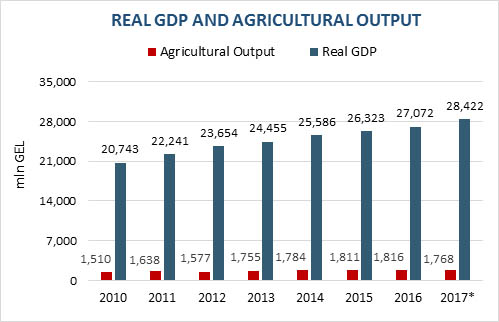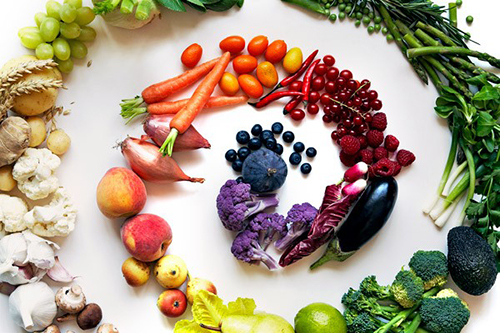- Details
During the last decade, real GDP of Georgia has been steadily increasing, while share of agriculture has been decreasing. The share of agricultural output in total GDP decreased from 6.7% on 2016 to 6.2% in 2017. Agricultural output decreased in absolute terms as well by 2.6% in 2017 compared to 2016.
In spite of the low share in GDP, employment in agricultural sector is rather high. Given that in rural areas employment opportunities other than in agriculture are quite limited, most of self-employment in rural areas is likely to happen in the agricultural sector. Self-employment figures range from 42% to 44% during 2010-2016.
- Details
In the last two weeks of February, ISET’s Retail Food Price Index increased by 5% (compared to February 2017). On a monthly basis (compared to January 2018), food prices in Tbilisi’s major supermarkets increased slightly, by 0.6%. We recorded the biggest bi-weekly price increases for bananas (10%), cucumbers (10%), and beef (4%). Prices dropped the most for garlic (-9%), rice (-6%), and potatoes (-5%).
PRICES OF DIFFERENT FOOD CATEGORIES IN MORE DETAIL
Looked at from an annual perspective (November 2017 vs. November 2016), on average, Tbilisi’s retail markets experienced substantial annual price increases in the five food categories that comprise the Retail FPI: grocery (4%), fruits (6%), meat (3%), dairy products (10%), and non-alcoholic beverages (2%).
- Details
In the first half of February, ISET’s Retail Food Price Index increased by 4.8% y/y (compared to February 2017). On a monthly basis (compared to January 2018), food prices in Tbilisi’s major supermarkets held relatively steady and decreased only slightly by 0.1%. The sharpest bi-weekly price changes were recorded for fruits and vegetables. Prices increased the most for eggplant (38%), garlic (19%), and carrots (8.2%). The largest price drops were observed for tangerines (5%), cucumbers (5%), and coriander (2%).
A CLOSER LOOK AT DAIRY MARKET
Dairy prices have shown a strong start for the year. As shown in the diagram, in January 2018, prices are higher for all dairy products compared to the same month of previous year: milk (12%↑), cheese (11%↑), butter (11%↑), and matsoni (5%↑). Given that in winter, there is a shortage in milk supply, increased dairy prices in that period can be explained by seasonality. While seasonality is a good explanation for monthly changes, it cannot explain annual changes in prices.
- Details
At the end of January, ISET’s Retail Food Price Index increased by 5.2% y/y (compared to January 2017). On a monthly basis (compared to December 2017), food prices in Tbilisi’s major supermarkets decreased slightly by 0.3%. According to data from the last two weeks of January, prices dropped the most for buckwheat (-6%), rice (-6%), and bananas (-2%). Among the sharpest price increases was an 8% rise in the price of wheat flour and tangerines, while milk and frozen chicken climbed 3%.
WORLD FOOD PRICES ON THE RISE
ISET’s Retail FPI ended a year on a high note: retail food prices picked up in December 2017, showed a significant rise of 10% year-on-year, and had the highest reading in three years (since the Index was launched in November 2014). After facing expensive Christmas dinners, Georgian consumers might be relieved as food inflation cooled to 5.2% in January 2018 (compared to January 2017).














